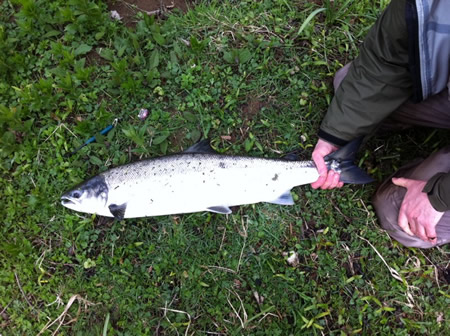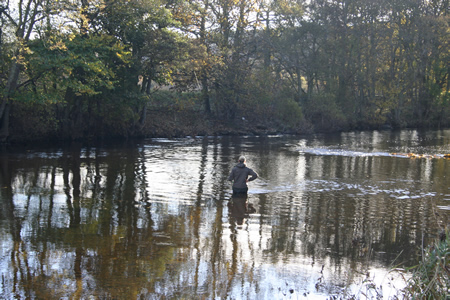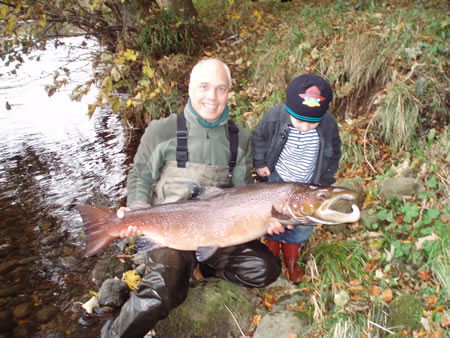These bulletin blogs represent news about Finavon and the South Esk, and my views as a riparian owner. They are not the views of any other organisation, nor are they designed to promote the interests of any individual or organisation other than Finavon Castle Water and factors affecting the fishery. Tony Andrews
2012 has been a strange season on the South Esk. We have never quite known, right up to the last days of the season, whether it was to be a season of plenty or famine. In the end it was neither and ended as a curate’s egg of a season – good in parts and bad in parts.
MSW fish like this one were a feature of the season, but there were also some undersized, ill-fed grilse among catches at Finavon. It seems that the marine migration experience of our 1SW fish (grilse) is very different from that of our MSW fish, which may confirm the views of ecologists that the ‘near’ feeding areas in the Norwegian Sea, within the range of grilse, are much less productive than the western part of the North Atlantic in terms of salmon prey species. Two factors – numbers of returning fish and condition of those survivors – support that theory.
I received an interesting e-mail this week which remarked,
“Had just finished fishing on Tuesday morning and was buzzed by a helicopter flying up the river with a fancy aeriel sticking out of a skid. I would suspect that they were trying to find some tagged fish, were they successful ? I wonder if the 12lb cock fish which I had just landed and returned was one of them !
I have had a great few days, four fish (and) I must say that I have seen more fish this year in the last week than ever before.”
If only Marine Scotland had enough money to hire helicopters, and if they did I do hope they wouldn’t waste their money on chasing just 12 radio tagged fish in that expensive way! But, more to the point, isn’t it interesting that someone who lives and fishes in the Tannadice area should have such a positive view of the abundance of salmon in the river? Such observations are always of interest, but of course they are only little pieces in a large and complex jig-saw of observational data. It is quite possible in a river, as subject to variable flows as the South Esk is, that certain sections of the river become stopping areas for adult fish on their upstream migration, especially in the late season close to spawning time. The same applies to sea trout which, as happened about ten years ago at Brechin Castle, can ‘favour’ a section of the river and form huge shoals in pools in that part of the river. I think the message is “take all reports with a pinch of salt and use them to build the big picture”!
After an e-mail discussion my friend sent this e-mail, which I think also makes interesting reading:
“The chopper was definitely following the river and at about 150 feet, was not the police looking for a body, definitely had a fancy aeriel though. could see it through the “Rommels”.
I was fishing Forfar water, this is the opposite bank at Tannadice from down river at Justinhaugh to past the old railway bridge at Barnyards. It is not bad if you catch it right as any fish in the system tend to plough straight on. However friends of John Grieve were fishing Inshewan at the same time and between two of them only had two fish for the week. I must say that I saw quite a few fish and a few brutes. I did not have a camera with me as I tend to have enough to do to fish when I am by myself !! The first three fish were all still silvery two cocks and one hen. Both cock fish were about 5lb and the hen over eight. The last fish on Tuesday was the biggest a cock fish over 12lbs a bit coloured but a beauty really deep bodied and strong, took a bit to recover but swam away strongly. All caught on the same fly, bright orange Flame Thrower tied by my own fair hand fished on a floating line. The leaves were becoming a pest.”
FCW Catch returns for 2012
| Beat | No of Salmon | No of Grilse | No of Sea trout |
| Milton | 76 (55.47%) | (14) | 75 (46.58%) |
| Bogardo | 19 (13.80%) | (3) | 24 (14.90%) |
| Castle | 16 (11.67%) | (2) | 17 (10.55%) |
| Indies | 26 (18.90%) | (6) | 45 (27.95%) |
| FCW | 137 (100.00%) | (25) | 161 (100.00%) |
The fine performance of Milton Beat may be attributed to 2012 being a very wet year. In a previous blog I commented on the ‘plateau effect’ which seems to favour the stretch of river between Tyndals Pool and the tail of the Flats, especially in high water.
William Simper fishing a long line through the best part of Volcano Glide on Milton Beat in the last week of October 2012. Volcano is a star performer among the pools of FCW and, as the catch return above shows, Milton Beat was by far the best beat in 2012, but that is not always the case because high water levels favour the ‘plateau’ of Milton Beat.
FCW in context of recent seasonal rod catches of the South Esk
Catches from selected beats (Cortachy & Downie Park, Inshewan, Finavon and Kinnaird Upper, Middle & Lower) over the last five seasons, including 2012.
Salmon
| Beat | 2008 | 2009 | 2010 | 2011 | 2012 | Av. |
| CC & DP | 143 | 158 | 153 | 146 | 117 | 143 |
| Inshewan | 147 | 99 | 118 | 153 | 112 | 126 |
| Finavon | 221 | 103 | 136 | 139 | 137 | 147 |
| Kinnaird | 204 | 161 | 460 | 123 | 74 | 228 |
| Totals | 715 | 521 | 867 | 561 | 440 | 621 |
Sea trout
| Beat | 2008 | 2009 | 2010 | 2011 | 2012 | Av. |
| CC & DP | 120 | 236 | 275 | 128 | 102 | 172 |
| Inshewan | 52 | 111 | 126 | 101 | 110 | 100 |
| Finavon | 100 | 118 | 121 | 101 | 161 | 120 |
| Kinnaird | 112 | 197 | 203 | 207 | 193 | 182 |
| Totals | 376 | 662 | 725 | 523 | 566 | 570 |
Note: I think it is reasonable to claim that these four fisheries (see tables above) produce about three fifths (60%) of the rod catch for the whole river. With fisheries such as Careston, Kintrockat, Justinhaugh, House of Dun, Brechin Castle, BAC, KAC, FAC, Braedownie, the whole of the Prosen, and others not included in the catches above, it is perhaps reasonable to claim that those fisheries together produce the other two fifths (40%). Recent rod catch returns for the river have diminished taking the river from 17th to 24th in the list of UK rivers in order of average salmon catches. It would be good to see this trend reversed, which may come about with increased fishing effort, especially in the spring, but that can only happen if there is more confidence in the river from the angling community.
Ian Hardy’s big salmon from Marcus. Fish of this size (see photo above) have been present in the South Esk during most seasons. A well conditioned cock fish of 31lbs (probably 35lbs+ when it entered the river) preparing to spawn tells us that something is going right. We might speculate on the life story of this fish (sorry, I don’t have scales) from ovum to returned survivor, but what we can see is that this MSW salmon, most likely 3SW, made it to sea as a smolt, survived inshore threats (predation and suchlike) successfully migrated to its oceanic (Greenland maybe) feeding grounds, and returned in good condition to the South Esk; a round-trip of 6,000 miles as the fish swims. He is still alive, and I hope powering up to find some sexy hen fish with whom to mate over a well dug redd somewhere in good clean cobbles upstream.
With the bad press the river gets it is not surprising that some beats have had difficulty in filling letting slots. It is too easy to attribute reduced rod catches to lower numbers of fish in the river. There are other factors at play here, and no-one should assume that any one of them is the single cause of any perceived or actual decline in numbers. The truth is that we don’t know and, to find out what the real situation is, we now need to invest in counting salmon into the river and measuring recruitment from ova to smolt. That investment is long overdue. A new board will be elected next spring, and let us all hope that a new direction of management for the South Esk starts with sound data, building on what we already know. When we have the facts we can concentrate all our efforts on resolving any identified problems. As a meercat might say, “simple..ckhckhckh!”
TA 2nd November 2012


